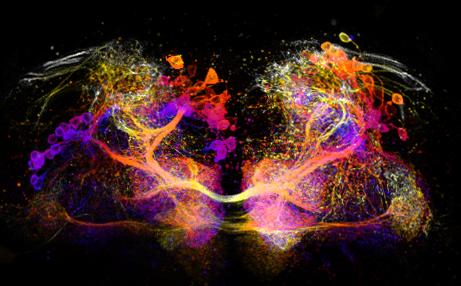
Credit: Laboratory of Neurophysiology and Behavior at The Rockefeller University
As animals explore their environment, they learn to master it. By discovering what sounds tend to precede predatorial attack, for example, or what smells predict dinner, they develop a kind of biological clairvoyance–a way to anticipate what’s coming next, based on what has already transpired. Now, Rockefeller scientists have found that an animal’s education relies not only on what experiences it acquires, but also on when it acquires them.
Studying fruit flies, the researchers showed that a single odor can become either appealing or disgusting to an animal, depending on when the smell is encountered relative to a reward. The study, described in a report in Cell, also reveals that animals can quickly revise these memories, and shows how this process unfolds on a cellular level–insights that likely pertain not just to flies, but to learning across the animal kingdom.
Which came first?
Memory, at its most fundamental level, amounts to a series of associations: Ring a bell before feeding a dog, and eventually the dog will learn to salivate at the sound of the bell alone.
“In this case, the bell comes before the food and is therefore predictive of reward,” says Annie Handler, a graduate fellow in the lab of Vanessa Ruta, the Gabrielle H. Reem and Herbert J. Kayden Associate Professor. “But we suspected that there isn’t just one order of events that animals find significant. They should also be able extract meaning from cues that follow a reward.”
For example, if a dog hears a bell after its meal concludes, then it should develop a negative association with that sound, as it signifies the end of chow. Hoping to better understand how timing affects memory, Ruta and Handler examined the brains and behavior of fruit flies.
Rather than supply the animals with tasty treats, the researchers used a technique called optogenetics to stimulate neurons that normally become active when an animal receives a reward, an approach that allowed them to precisely control the timing of positive feedback. They found that if these neurons were stimulated immediately after an otherwise neutral odor, the flies developed an attraction to that smell. Conversely, if they activated the neurons just before exposing flies to the same odor, the animals began to avoid it.
“The difference in time is only one or two seconds, yet the flies form completely opposing associations,” says Handler. “Somewhere in the brain that difference of a second–of whether the odor comes before or after the reward–makes a huge difference.”
The fact that brains have a sense of timing may seem intuitive; but exactly how neurons encode the sequence of events on a cellular level is far from obvious. Relatively small and simple, the fly brain offers a unique opportunity to study the neural circuits underlying this phenomenon–and that’s exactly what Ruta and Handler did.
Remaking memories
To determine how flies discriminate the timing of events, the researchers monitored changes in a brain region called the mushroom body. Known to be involved in associative learning, this area contains Kenyon cells, which carry odor signals, dopamine neurons, which carry reward signals, and output neurons that regulate a fly’s attraction to an odor.
Kenyon cells can be either strongly or weakly connected to output neurons; and dopamine tunes the strength of these connections, or synapses. If a Kenyon cell detecting a specific odor forms a weak connection with an output neuron, the animal becomes attracted to that odor; if this synapse grows stronger, however, the smell will become meaningless, or even aversive to the animal. Analyzing this type of connection, Ruta and Handler identified a signaling pathway that can either strengthen or weaken synapses, depending on the precise moment when dopamine neurons become active.
“This pathway is time sensitive, so whether the dopamine neuron is activated before or after an odor makes a critical difference in the strength of connections between cells in the mushroom body,” says Ruta. “And we believe this is the mechanism by which the brain figures out the sequence of events.”
By tinkering with this pathway, the researchers also found that they could quickly make strong synapses weak and vice versa, suggesting that memories can be erased just as quickly as they’re formed. And when they analyzed fly behavior, they found further evidence of the ability to revise mental associations.
“We performed 50 trials. Each time we switched the timing of the odor relative to the reward; and each time the animal became more or less attracted to the odor, depending on what it had experienced a minute prior,” says Handler.
In other words, even if a fly had previously learned to associate an odor with reward, it could quickly unlearn that association if the smell failed to predict reward in future trials. Memories are not set in stone; rather, they’re set in synapses, which can be modified as an animal’s environment and experiences change. Indeed, this experiment highlights that survival depends not just on the ability to form memories, but also to forget them.
“There are so many things that we could remember on a daily basis, so we hold on to the memories that turn out to be predictive; and we toss out associations that are incorrect or irrelevant,” says Ruta. “When you live in a dynamic environment–which both flies and humans do–that seems like a very good strategy.”
###
Media Contact
Katherine Fenz
[email protected]
Original Source
https:/
Related Journal Article
http://dx.




